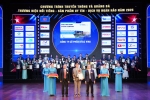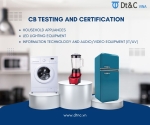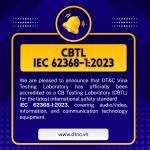1. What is Specific Absorption Test?
Specific Absorption Rate (SAR) testing is a testing process that evaluates the rate of energy absorption by the human head, body or limbs when using mobile devices with exposure to radio frequency (RF) electromagnetic fields. This testing gives manufacturers a more accurate measure of the level of radio frequency exposure they can put in their products while still complying with regulations.
SAR testing determines the amount of RF energy absorbed by the body, especially in areas with the highest absorption, such as the head and trunk. Results are expressed in watts per kilogram (W/kg), which represents the amount of RF energy absorbed per unit of body mass. For regulatory requirements, SAR levels are averaged over a 10g mass typically for European regulatory requirements and a 1g mass for North American regulatory requirements.
2. Why is it necessary to conduct SAR testing?
Through the concept mentioned above, we can see that SAR testing is very important because it ensures the safety of wireless devices. By measuring the amount of RF energy absorbed by the body, manufacturers can ensure that their devices comply with international safety standards. Furthermore, these standards are established by reputable organizations such as the International Commission on Non-Ionizing Radiation Protection (ICNIRP) and the Federal Communications Commission (FCC). It is a legal requirement in many countries, different regions have specific SAR limits that the device must comply with in order to be considered safe to use.
One of the main concerns of this testing regarding exposure to RF radiation is the potential for thermogenic effects, in which absorbed energy can lead to increased body temperature. SAR testing helps determine whether a device emits RF energy at levels that could contribute to thermal effects.
3. When should SAR testing be applied?
As can be seen, it is extremely important to understand and define product usage in order to understand when and how to apply SAR testing.
Examples include products such as mobile phones where the manufacturer has stated that it is to be used with the user's body at a distance of 15mm when in reality most users place the device in their pocket. their. Thus, the case of using bags at 0 mm to 5 mm must be evaluated. Similarly, if a device is classified as hand-only when it can be placed in a pocket of clothing such as a jacket while transmitting a signal then body conditions also need to be applied.
Other important conditions to consider are whether the device being tested is intended for public use or for professional use.
If the device is used for professional purposes, the SAR limits will be less stringent. Because professional users may have received training on how to operate their devices and how to limit exposure to RF radiation from those devices. In addition, the equipment may also have been designed according to limitations relating to occupational use. In this case, manufacturers need to make sure that the device is not used for public purposes.
When SAR testing results do not comply with regulations, in most cases the solution is to reduce the output power of the product. However, this will negatively affect the device's performance. Therefore, it is important to understand when a device under development needs SAR testing and ensure that it is done as early as possible in the product's development cycle.
4. Some typical devices and products need SAR testing
- Mobile phone
- Tablet
- Laptop
- Wearable devices
- Wireless phone
- Monitors
- Medical devices
- Wireless gaming device
- Bluetooth headphones and headsets
- Industrial equipment
Specifically:
MOBILE PHONES AND SMART PHONES:
SAR testing is mandatory for mobile phones and smartphones. Because these devices are close to the user's body, especially during calls, SAR testing ensures that the RF energy emitted is within safe limits. Mobile phones need to be considered for all the different user scenarios, devices can also operate at different output power levels for each of those scenarios. This needs to be considered both during testing and in determining the test plan, as testing may need to be repeated for each use case.
WIRELESS CONSUMER PRODUCTS:
Devices such as tablets, smart watches and other wireless communication devices used near the body are subject to SAR testing. This includes devices with wifi, bluetooth and cellular connectivity. Some devices of this type can be used in the hands or on the limbs. This may allow those devices to relax their SAR testing limits a bit. This limitation is because the limbs do not contain any major organs and are mainly made up of skin, bones, and muscles. For the smartwatch example, this could be classified as hands-only but if you can speak into the smartwatch then you have to consider the distance between the user's face and the device when speaking in it.
MEDICAL DEVICES:
Some medical devices that use wireless technology, such as wearable health monitors or implantable devices, may also require SAR testing according to national regulatory requirements.
WIRELESS INFRASTRUCTURE:
In addition to individual devices, SAR testing can sometimes be applied to wireless infrastructure components such as antennas and base stations to ensure that overall RF exposure is within acceptable limits. . As the use of small office base station (Pico-cell) infrastructure technologies becomes increasingly popular, how they are installed in the workplace must be considered. In the case of a base station, the compliance distance of the device is often very important. If you know the minimum distance at which a user can approach equipment while still meeting regulatory requirements, you can easily assess where that equipment should be placed in the workplace.
5. Some necessary documents and international standards for SAR testing
a) Required information before testing:
- Antenna diagram
- Band/Technology that the device supports
- Class/Modes - 2G, 3G, 4G, 5G,..., Wifi, Bluetooth
- Maximum power and tolerances
- Simultaneous transmission combinations
b) Some international standards:
- EN 50360: 2017
- EN 62209-1: 2016/IEC 62209-1: 2016
- EN 50566: 2017
- EN 62209-2: 2010/IEC 62209-2: 2010 + Kor.: 2010
- EN 62209-2:2010/A1:2019
- EN 50383: 2010
- EN 50385: 2017
- EN 62232: 2017
- EN IEC 62311: 2020/IEC 62311: 2019
- EN 50663: 2017
- EN 62479: 2010
- IEC/IEEE 62209-1528: 2020
- IEC/IEEE 62209-1528: 2020
- IEEE C 95.1-1992/IEEE C 95.1-1999 / IEEE C 95.1-2005
- IEEE C 95.3-2002
- IEEE 1528-2013
- IEC/IEEE 62209-1528: 2020
- RSS-102 Issue 6: 2023
- RSS-002 Issue 1: 2016
- Safety Code 6: 2015
- RSS GEN Issue 5
- ARPANSY standard RPS S-1: 2021
- RPS S-1 Advisory Note
- AS-NZS 2772.1: 1998
- EMR Standard 2014. Radio communications (Electromagnetic Radiation — Human Exposure) Standard 2014
- AS/NZS 2772.2: 2016
- Article 14-2 of the ordinance regulating radio equipment RPS S-1 Advisory Note
- Annex 79 of MIC Notification No. 88
Through the basic information about SAR testing mentioned above, we have seen its importance and learned that currently in the world, in many countries such as the US, Canada, Australia, Japan, European countries have been promulgating standards and applying regulations related to mandatory SAR testing for radio transceiver products. To protect users and improve safety in information technology, Vietnam's Ministry of Information and Communications has also drafted National Technical Regulations on Specific Absorption Levels for Mobile Phones - QCVN 134 :2024/BTTTT.
Reference article:









![[MIC] Officially issued QCVN 134:2024/BTTTT - National technical regulation on specific absorption levels for handheld and body-worn radio devices according to Circular 19/2024/TT-BTTTT of Ministry of Information and Communications](https://cdn0577.cdn4s.com/thumbs/qcvn-134_thumb_150.jpg)



![[Latest] Circular 02/2024/TT-BTTTT regulating the List of potentially unsafe products and goods under the management responsibility of the Ministry of Information and Communications](https://cdn0577.cdn4s.com/thumbs/trang-huy-hieu-the-loai-logo-2_thumb_150.jpg)